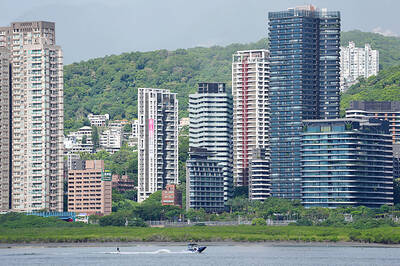Stephen Briggs popped open his pocket knife, carved a wedge from a small pink and green apple and took a bite.
“Those are ready,” he said, looking at a nearby apple tree, one of 4,500 planted in neat rows through wheat fields on his farm near Peterborough in eastern England.
The wheat had been harvested a couple of weeks earlier, but Briggs welcomed the added work of apple picking and the extra income it provides.
He is among a small group in the UK working to revive the ancient practice of agroforestry, or growing trees on the same piece of land as field crops or livestock pasture for economic and ecological benefits.
The farming method all but disappeared in the UK in the wake of World War II, when the government, under pressure to feed a rapidly growing population, paid food producers to switch to single-crop farming methods.
Yet agriculture experts say it is poised to make a comeback as part of the government’s tree-planting campaign to help meet its climate target of net zero carbon emissions by 2050.
“Nature doesn’t do monoculture,” said Briggs, an early adopter of the practice who is advising the government on agroforestry standards.
“We’re taking some of the best practices of forestry and mixing them with agriculture to embed diversity, to be resilient, but in a way that we can still manage,” he said.
In a report released this week, the Woodland Trust, a British conservation charity, said planting 30 percent of British grass pastureland with trees could produce net zero carbon emissions from pasture-raised livestock by 2050.
The UK committed more than £500 million (US$569 million) to planting 30,000 hectares of trees per year between 2020 and 2025.
About 70 percent of the country’s total area is agricultural land, but only a little more than 3 percent of British land is used for some form of agroforestry, said Paul Burgess, an professor of sustainable agriculture and agroforestry soils, agrifood and biosciences at England’s Cranfield University.
In its 2020 report, the independent Climate Change Committee recommended increasing the area of farmland that incorporates trees to 10 percent, saying that it could cut planet-warming emissions by 6 tonnes per year by 2050.
Burgess said that planting trees on agricultural land can cut more emissions than planting trees on non-agricultural land, with trees in some cases leading to reduced fertilizer use or a lower density of beef cattle, a key source of climate changing emissions.
However, even proponents of agroforestry say making the practice more widespread would not be easy — not least because there is a lack of available trees to plant.
“If agroforestry was to take off at the level that we would all like to see, we don’t have the tree supply [nationally],” said Helen Chesshire, lead farming advocate for the Woodland Trust, which gives grants to farmers to plant trees.
“Currently, we have a bottleneck,” she said.
FARMING OVER FORESTS
Farming with trees in a multi-crop system is not a new idea. People have used the technique for thousands of years, including on the British Isles, and it is still the method of choice on vast swathes of the planet.
Farmers and other agricultural experts say agroforestry boosts biodiversity, aiding vital pollinators such as bees and birds, while reducing instances of pest and disease infestation for plant crops and livestock.
For instance, spreading fruit or nut trees throughout a crop field, rather than grouping them together in an orchard, makes it harder for disease to jump from tree to tree.
The practice also slows land degradation as trees store nutrients and water in the ground, protect soil against wind erosion, and buffer crops against flooding.
All can help counter the effects of rising temperatures and intensifying drought, experts say.
Despite the benefits of multi-crop systems, a range of European and UK agricultural policies, starting in 1962, incentivized farmers to clear trees to grow more monocrops, Briggs said.
That created “a chasm” between agriculture and forestry, which over the past decade a coalition of farmers, ecologists and nonprofits have been lobbying the British government to close, he said.
Since the UK left the EU in 2020, all four of its national governments have announced the development of agroforestry standards and payment programs to encourage more trees on farms.
“The government now seems to at least accept that trees on farms are no longer an issue, that they are part of the farming system,” Chesshire said.
‘CHANGE IS A CHALLENGE’
Advocates say policy incentives are the crucial first step to upscaling agroforestry.
Tackling the country’s tree shortage would take time, Chesshire said, adding that the trees should be cultivated domestically to avoid importing invasive species or diseases that could risk the entire system.
The next step, supporters say, is raising basic awareness of agroforestry techniques.
“People make the mistake ... of assuming that farmers are foresters, and they aren’t. Change is a challenge for them,” said David Brass, chief executive officer of The Lakes Free Range Egg Co in Cumbria.
The Lakes sources eggs from more than 70 farms and requires all of its producers to have 20 percent of the area their hens range in covered in trees, Brass said.
The company provides initial payments to many reluctant farmers to plant trees and pays a “significant premium” for ongoing maintenance, he said.
On his own farm, Brass said his investment paid for itself within the first two years. Hen mortality dropped and egg quality increased.
As descendants of jungle fowl, chickens are happier and more secure among trees, he said, adding that trees also shield the animals from increasingly extreme temperatures.
TIME FOR A REVIVAL
Another challenge farmers face when looking to move into agroforestry is time. Trees can take anywhere from five to 70 years to mature, depending on the species.
“Asking tenant [farmers] to invest in trees if they have a five-year tenancy and apples take beyond five years to get anywhere near a return is problematic,” said Matthew Heard, an ecologist in charge of environmental research at the National Trust, Britain’s largest private landowner.
“That’s where stepping up as a landlord is really important,” he said.
In addition to adjusting lease terms so that landlords offer longer tenancies, farmers also want the government to extend its sustainable farming payment scheme from covering three years at a stretch to eight years, in light of the multi-year financial risk they take until trees are established.
For all the challenges, agroforestry advocates say the boost for food security and economic productivity, as well as the environmental benefits, far outweigh the costs.
On his farm, Briggs pointed to a petrified tree trunk on the edge of a field.
“Before we farmed the area, there were trees here,” he said. “We have to put trees back into the landscape in a way we can manage. This is what the land returns to.”

Taiwan’s rapidly aging population is fueling a sharp increase in homes occupied solely by elderly people, a trend that is reshaping the nation’s housing market and social fabric, real-estate brokers said yesterday. About 850,000 residences were occupied by elderly people in the first quarter, including 655,000 that housed only one resident, the Ministry of the Interior said. The figures have nearly doubled from a decade earlier, Great Home Realty Co (大家房屋) said, as people aged 65 and older now make up 20.8 percent of the population. “The so-called silver tsunami represents more than just a demographic shift — it could fundamentally redefine the

Businesses across the global semiconductor supply chain are bracing themselves for disruptions from an escalating trade war, after China imposed curbs on rare earth mineral exports and the US responded with additional tariffs and restrictions on software sales to the Asian nation. China’s restrictions, the most targeted move yet to limit supplies of rare earth materials, represent the first major attempt by Beijing to exercise long-arm jurisdiction over foreign companies to target the semiconductor industry, threatening to stall the chips powering the artificial intelligence (AI) boom. They prompted US President Donald Trump on Friday to announce that he would impose an additional

China Airlines Ltd (CAL, 中華航空) said it expects peak season effects in the fourth quarter to continue to boost demand for passenger flights and cargo services, after reporting its second-highest-ever September sales on Monday. The carrier said it posted NT$15.88 billion (US$517 million) in consolidated sales last month, trailing only September last year’s NT$16.01 billion. Last month, CAL generated NT$8.77 billion from its passenger flights and NT$5.37 billion from cargo services, it said. In the first nine months of this year, the carrier posted NT$154.93 billion in cumulative sales, up 2.62 percent from a year earlier, marking the second-highest level for the January-September

Asian e-commerce giant Shein’s (希音) decision to set up shop in a historic Parisian department store has ruffled feathers in the fashion capital. Anger has been boiling since Shein announced last week that it would open its first permanent physical store next month at BHV Marais, an iconic building that has stood across from Paris City Hall since 1856. The move prompted some French brands to announce they would leave BHV Marais, but the department store had already been losing tenants over late payments. Aime cosmetics line cofounder Mathilde Lacombe, whose brand was among those that decided to leave following